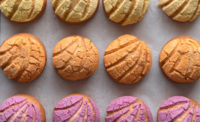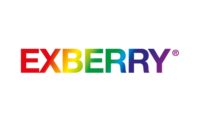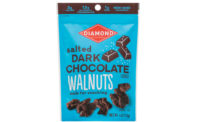It’s vital to get flavor and color right when developing snack and bakery products. Color helps establish the consumer’s initial expectations of a product, and flavor is a critical part of delivering against those expectations. Flavor is a key driver of snack sales, notes Sally Lyons Wyatt, executive vice president and practice leader, IRI, Chicago. She notes that the majority of consumers identify taste/flavor as the top purchase driver for snacks.
“I predict that taste will always be No 1,” says Lyons Wyatt. Consumers still love cheese, she notes. They still love chocolate. “But they love combinations, too. Make sure when you look across your portfolio, you pack it with different flavors. Be able to appeal to all the generations with the variety of flavors that are necessary, from sweet all the way to hot.”
IRI notes that there has been an explosion of flavor combinations in snacks over the past few years, citing 4,160 flavor combinations, of which 2,194 had dollar growth in 2018 versus 2017.
With the start of the New Year and the new decade, companies are making predictions about which flavors and colors will trend and resonate with consumers.
Flavor forecasts
Consumers continue to seek new flavor experiences. “Dragonfruit (aka, pitaya or strawberry pear) is attracting the attention of consumers due to its sweet and sour flavor profile,” says Anu Fisher, marketing analyst, Flavorchem, Downers Grove, IL. “The vibrantly pink fruit is also photo-friendly and gaining widespread appeal through social media. Dragonfruit is also a flavor that pairs well with other fruit flavors including kiwi, pear, and strawberry. While the flavor has been seen in beverages in recent years, expect it to be more prominent in snacks, frozen desserts, and bakery items.” She notes that an example of a current on-trend product featuring the flavor is Supernola Dragonfruit Lemon Zest granola.
Yuzu is also seeing broader appeal. “Tart, sour, and fermented flavors are gaining momentum in food and beverage products and will take off in 2020,” predicts Fisher. “Market analysts all agree that the tart, citrus Japanese fruit, yuzu, will see a surge in popularity in the U.S. Yuzu is the perfect combination of adventurous and global flavor blending with the tart taste profile consumers are seeking. They are looking to experiment with new citrus profiles and exotic flavors that offer the perception of sweetness without added sugar, syrups, or artificial sweeteners.” Golden Door Farms offers Yuzu Lemon Cookies.
Cardamom is a spice to watch, suggests Fisher. “As spices traditionally used in ethnic cuisine become more mainstream in the U.S., expect a rise in the usage of cardamom in non-traditional applications. Cardamom is popular in both Middle Eastern and Indian dishes, so the flavor is becoming more adaptable to American palates, especially Millennial and Gen Z-ers. Its broad appeal covers a wide range of savory and sweet applications including indulgent baked good.” NutHouse recently released a Blueberry Cardamom Granola, and Unna Bakery does a Cardamom Crisp cookie.
Kerry, Beloit, WI, notes that “snackification” is a key trend that creates an opportunity to innovate new flavors in snack foods across different dayparts. With consumers shifting to eating more snacks throughout the day in place of traditional meals, it allows consumers to experiment and try new flavors at different times of the day.
“The snackification of consumer eating patterns means that snack foods are often the main avenue by which new flavors and tastes are introduced to the general public for trial in small amounts,” says Erika Minaguchi, senior marketing executive, beverage and sweet taste, Kerry Europe and Russia. “Snack foods are an important avenue by which new flavors and tastes become established in our food culture and, eventually, cuisine. For example, ‘snackification’ allows consumers to test and try an interesting new flavor from the Middle East, Asia or Africa in a small serving, such as chips, crackers, or other products.”
Kerry recently launched its 2020 Taste Charts, the culmination of a food and beverage landscape review that factors in sales performance, consumer trends, foodservice influences, and internal culinary expertise. “Kerry’s predictions forecast that 2020 will bring further specificity to the origin of flavors and ingredients as consumers seek tastes that delight, surprise, and excite them. We are also expecting Middle East flavors and ingredients to continue influencing Western taste profiles, with profiles like za’atar and sumac being used to add a layer of sophistication across categories,” shares Minaguchi.
“For sweet, we are seeing savory flavors becoming more established within the category, with profiles such as herbs and spices,” says Minaguchi. “This speaks to how manufacturers are looking to work around sugar reduction through flavor innovation, and also how consumers’ mindsets are moving toward less-sweet profiles. Kerry is also seeing alcohol profiles playing a role within the sweet and salty snack categories.”
ADM, Chicago, notes that spicy flavors are on the rise, especially among younger consumers, and predicts that snack foods and savory bakery products that incorporate exotic, spicy, and globally inspired flavors will likely see growth this year. “In 2020, we foresee greater acceptance and growth of tropical and exotic citrus flavors, including mango, passionfruit, yuzu, calamansi, mandarin, clementine, and bergamot. African spice blends such as berbere, ras el hanout and harissa will also continue to gain popularity,” says Brad Schwan, senior director, marketing, ADM.
“In the coming year, we also anticipate expanded interest in pink flavors, such as pink peppercorn, as part of a wider acceptance of botanicals and exotic ingredients combined with flavors consumer already know and love,” says Paula Labine, marketing director, milling, ADM. “When it comes to bakery products, exotic flavors such as lychee or passionfruit—paired with more mainstream flavors—is a great way to offer a twist on the familiar.”
Kalsec, Kalamazoo, MI, conducted its own hot and spicy research in 2019 to keep its finger on the pulse of the latest flavor trends. The study showed that more than half of global consumers surveyed said they’re eating spicier foods more often than they were a year ago. As a result of the growing interest in spice, the company has seen a rise in Middle Eastern and African foods and flavors, such as harissa, an aromatic and spicy North African chile paste.
“The specificity of the spice becomes even more popular when paired with a familiar flavor,” says Jill McKeague, executive director of product management, spice and herb flavor extracts, Kalsec. “We’ve developed three new flavors for 2020 that combine the pepper-specific and familiar flavor trends: Ancho Orange, Chipotle Blood Orange, and Jalapeño Lime. These new combinations leverage a specific spice paired with an equally trendy citrus note.” The company is seeing these flavors being used in chips, crackers, nuts, snack bars, jerky, and popcorn.
McKeague notes the popularity of foods that offer familiarity with a flavor twist. “One example of this is within the Tex-Mex category, which is evolving to include more nuanced and specific flavors, including those from other Latin American regions such as Argentinian chimichurri. We predict this flavor will trend as consumers seek more authentic Latin American flavors that carry regional flair and authentic spicy flavors.”
Single-origin clout
Vanilla extract is a fundamental ingredient in many baked goods, including cakes, cookies, brownies, and cupcakes. In response to the growing demand for global flavors, Nielsen-Massey Vanillas, Waukegan, IL, recently introduced two new single-origin vanillas from Uganda and Indonesia, increasing the offering to five single-origin pure vanilla extracts in their portfolio.
“Vanilla is one of nature’s most complex flavors and can exhibit a wide spectrum of flavor profiles,” says Bill Bond, vice president of global sales, Nielsen-Massey Vanillas. “Each of our five vanilla origins has its own unique flavor profile depending upon the varietal of orchid and the unique terroir of the region where it’s grown. Each is uniquely suited for distinct culinary and baking applications.” A proprietary, slow, cold extraction process gently draws out and preserves the flavor compounds.
“Our Ugandan Pure Vanilla Extract is creamy-sweet with notes of chocolate and pairs well with snack and bakery applications that incorporate caramel, chocolate and citrus,” says Bond. “Indonesian Pure Vanilla Extract has a strong flavor profile with woody, smoky notes and can withstand high-heat and slow-baked applications.” These new single origin pure vanilla extracts can be used in cakes, cookies, doughnuts, breads, and bar applications.
Nielsen-Massey also offers Madagascar Bourbon and Pure Vanilla Bean Pastes. “The pastes are crafted from our pure, premium vanilla extracts and infused with real vanilla bean specks for visual flair,” says Bond. “Our pastes lend a sweet, creamy vanilla flavor to any application and have a thick consistency, similar to that of honey or molasses.” The pastes can be used to create a gourmet look and flavor in products such as shortbreads, pastry creams, and custards.
Worth its salt
SaltWorks, Woodinville, WA, recently introduced a new line of Smoked Salts made using its proprietary new Perfect Smoke Technology. “We use real wood hand-selected for superior flavor and aroma profiles, premium salts harvested from the world’s cleanest oceans, and proprietary ultra-clean cold smoking techniques to produce exceptional smoked salt. This new process produces one of the safest, cleanest, and most environmentally friendly all-natural smoked salts available,” explains Megan O’Keefe, business manager.
The Perfect Smoke Technology line includes Durango hickory, Yakima Applewood, Salish Alderwood, El Dorado Mesquite, and Fumée de Del Chardonnay Oak smoked salts. These smoked salts can elevate the flavor in snack and bakery products such as chips, nuts, soft pretzels, and bagels.
The company also offers a line of Fusion Salt that feature a variety of on trend flavors, for example, truffle, ghost pepper, black garlic and matcha. “Our Fusion salts are handcrafted using our proprietary infusion technique that naturally bonds real ingredients to each individual salt crystal,” shares O’Keefe.
Vibrant and bold
Vibrant and bold colors continue to trend forward in snack and baked goods. “Tried and true natural yellow and oranges are particularly popular in crackers, while aqua, blue, and purple colors are requested across the baked goods category—especially in frosting applications,” shares Carol Locey, director product management, colors, Kalsec. Consumers have a desire for cleaner labels and transparency, creating an industry-wide shift to naturally derived colors.
Cakes, frostings, and crackers receive frequent request for vibrant colors, notes Locey. For frostings, bold purple continues to be a common customer request. “We’ve developed a custom color solution that blends naturally derived blue and red pigments to create a purple color that achieves the desired vibrancy. We also identified a need for naturally derived red colors in snack and baked good formulations. Many of the existing natural color options only perform best in acidic conditions making them unsuitable for use in baked goods, such as cakes. To meet this need, we introduced a line of high-stability anthocyanin red hues. These red hues are naturally derived from fruits and vegetables and perform well in baked applications, maintaining a bright red color.” The company also introduced high-stability beet colors that work well in baked goods.
GNT Group, Mierlo, the Netherlands, is predicting that vivid blues and greens will be dominant color trends in 2020. “‘Shades of Aqua’ connect with consumer demands in several ways. They evoke nature, such as the sea and rolling landscapes, and green in particular is associated with freshness ad organic goodness. As well as its connection to the ocean, blue can provide an ‘Instagrammable’ edge to cakes, pastries, and sweet goods, helping products stand out from the crowd,” explains Maartje Hendrickx, market development manager.
The company is seeing increased demand for organic products and have expanded its organic offerings in the signature EXBERRY line. The portfolio now includes food colorings based on organic spirulina and organic beetroot, with the line now spanning an array of colors, including= blues, reds, yellows, oranges, and purples.
The new spirulina-based blue powders have significant color intensity, which means they can be used at reduced doses, notes Hendrickx. “Spirulina-based coloring can give baked products and complementary decorations the coloring they need to make an impact, and the powders are particularly well suited for use in dry mixes. We also have a new range of liquid and powdered red coloring foods that are 50 percent more intense, so they can be used at lower doses, as well. They’re free from added sugar and made from ingredients such as carrots, blackcurrants, radishes, blueberries, and sweet potatoes.”
The EXBERRY line of food colors can be used in muffins, cupcakes, pancakes, yeasted and sourdough breads, cereal bars, snacks, and extruded products.
Naturex, Avignon, France, part of Givaudan, recently launched a yellow food color designed for use in bakery products. “Obtained from orange carrot cultivated in Europe, VegeBrite Golden Yellow produces bright orange and yellow shades and can easily be used as an alternative to beta-carotene. Through the work of Naturex’s agronomy experts, the carrots are selected to have a higher carotene content than the market standard, optimizing both the dosage and cost in use. A gentle extraction process is used to produce the extract,” states Nathalie Pauleau, global product manager, natural colors. The product is available in liquid or powdered format and works well is brioche, rolls, cakes, custard, and flan.
In the world of natural colors, stability is king—a key challenge with some shades. ADM offers a patented blue color that’s stable to acid, light, and heat. This stable blue color is derived from the juice of huito fruit, sourced from the Amazon region of Peru, making it possible to achieve various shades of blue, green, purple and brown from a natural source, notes Schwan. The product can be used in a broad range of snack and bakery applications.





